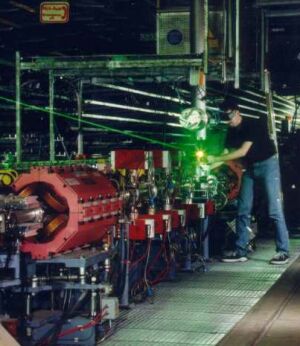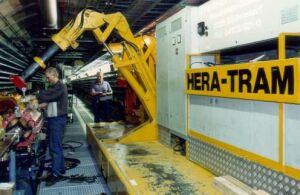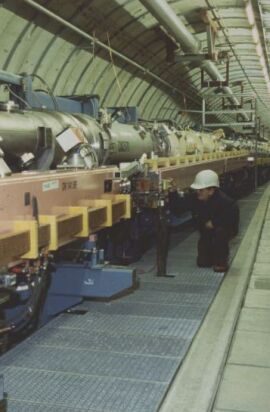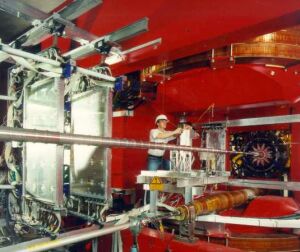URL: https://www.desy.de/news/news/archive_before_2010/2003/partphys0703/index_eng.html
Breadcrumb Navigation
Achievements for the remodeled accelerator facility HERA II shortly before shutdown
For the first time after the remodeling of HERA, all three spin rotator pairs running with a stable polarization degree of 50 %. Peak luminosity at HERA II achieved. Start of an 18-weeks shutdown period of HERA II. HERA-B successfully concludes first data taking for new physics program.
HERA II reached important objective: all three spin rotators working at first go

Workings on one of the two HERA polarimeters
Last week, after a very short optimization phase, the HERA crew succeeded in putting all three spin rotator pairs simultaneously into operation - two of them were recently built-in during the comprehensive remodeling of the accelerator facility - and very quickly achieved a polarization degree of the positrons of approx. 50 %. In this process, the spins, i.e. the rotational axes of the particles of the positron beam stored in HERA II were flipped into the direction of the beam in front of the interaction regions of HERMES, H1 and ZEUS and back on the other side of the detectors - for many hours, 47000 times per second. Also the two polarimeters which had to be removed and improved during the comprehensive HERA remodeling, worked at first go. In the north (H1) and south (ZEUS), positrons were brought into collision with protons even with activated detector magnets. This is not only the first time for HERA but also worldwide. All four HERA experiments were able to measure events with activated rotator pairs. After the current shutdown, polarization will open up an exciting new experimental program not only for both collision experiments but also for HERMES, which directs the polarized beam at a gas target. The use of polarized electron or positron beams on both collision experiments H1 and ZEUS was one of the two main aims of the HERA upgrade.
HERA II on the way to a fourfold "hit rate": peak value of luminosity achieved

The HERA tunnel in the comprehensive remodeling phase
The other one of the aims of HERA II is, that both collision experiments will be able to take a fourfold amount of data in order to be able to study extremely rare processes. For this purpose, the accelerators and detectors, mainly in the area of the interaction regions, were remodeled and equipped with new components. To increase luminosity - a value for the rate of collisions which is measured per unit of area and time - by a factor of four, the cross sections of the positron or electron beam and the proton beam before the collision had to be reduced to a third of their previous size, i.e. from only one hundredth of a square millimeter to even tinier three thousandths of a square millimeter. The proof that this ambitious aim was indeed achieved was given shortly before the present shutdown: in machine studies the HERA crew for the first time reached a luminosity peak value of 2.7 times 1031 cm-2s-1, which clearly exceeds the maximum of luminosity achieved by HERA I. Now it is evident that it is possible to reach the projected fourfold "hit rate" of HERA I - given the total number of particle bunches stored in HERA II and the planned particle current. The efficiency of HERA II was increased considerably in the previous weeks of the start-up phase, and both collision experiments took data with stable beam conditions and low beam currents.
HERA II: start of an 18-weeks shutdown to reduce the background rate

One of the six rotator segments in the HERA tunnel
Although it was shown, that after the comprehensive remodeling the HERA facility is able to reach the projected values, there were still unexpected serious technical problems, with the result that HERA II is still not running for the experiments with the design-values. Therefore, the operation of HERA II was interrupted on March 3, with the purpose to obtain afterwards the aspired fourfold collision rate. In this 18-weeks shutdown, technical work will be performed on the vacuum system of HERA II and also on some components of the H1 and ZEUS detectors.
After the extensive remodeled of the interaction regions, the start-up in 2001 proved to be much more difficult than expected. For the HERMES and HERA-B experiments, which only use one of both HERA particle beams, it was soon possible to produce good beam conditions. Nevertheless, both experiments could only start to take regular data in a restricted form because unexpected high background signals arose on the collision experiments H1 and ZEUS, which made data taking nearly impossible. With systematic tests and with close cooperation of the teams of the experiments, meanwhile, the HERA crew was able to find the source of the background problems and plan countermeasures which will be applied now.
HERA-B successfully concludes first data taking for new physics program

The inside of the HERA-B detector
The HERA-B experiment started operation in 2001 at HERA II with a new physics program and now looks back on a successful measuring period. Both, the necessary detector components as well as the electronic data taking system worked faultlessly. From several millions of events produced in highly energetic proton collisions, 350,000 events with the desired characteristic could be filtered out. These are J/Psi resonances consisting of a charm quark and its antiparticle. The HERA-B physicists then concentrated on the evaluation of these data. Some of the main questions deal with the strong force, i.e. how particles from charm quarks are produced within the atomic nuclei and how they react with other matter in the nucleus, whereby HERA-B is able to advance in regions so far impossible to reach for other experiments.
One of the fundamental questions of particle physics is the examination of the asymmetry of matter and antimatter in the universe. Why is the universe composed primarily of matter although the big bang produced matter and antimatter in equal quantities? Until two years ago, this so called CP violation could only be examined in the system of K mesons - a lighter species of particles. The confirmation of the CP violation in the system of the heavy B mesons was missing. These processes occur very rarely, making it necessary for examination to produce an extremely high amount of data which have to be processed by the experiments. The accelerator centers KEK in Japan and SLAC in the United States decided in the beginning of the 1990s to build specialized electron-positron storage rings (the so called B factories) with one detector each. DESY decided to use the proton beam, to be stored in the existing HERA ring, and to build the detector HERA-B - a technological challenge because, compared to the electron-positron detectors, no prototype for HERA-B existed and completely new methods of detection had to be developed and tested. This means, in particular, detector components with so far unprecedented radiation hardness and the electronic data acquisition system that every second has to deal with an amount of signals equivalent to the flood of information that passes through Deutsche Telekom's entire network. In the year 2000 it was evident, that the experiments on both B meson "factories" would reach their goal more quickly, so that the HERA-B group decided to use their detector to investigate other physics questions. The achieved developments however are pioneering work for future experiments of this kind, where similar harsh conditions will pertain, i.e. experiments with the Large Hadron Collider (LHC), the proton-proton accelerator currently under construction at CERN. Several members of the HERA-B group meanwhile went to other accelerator centers as sought-after specialists in this field. Part of the group decided to participate in the new physics program at HERA II and now starts with the first data analysis.


